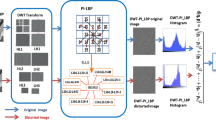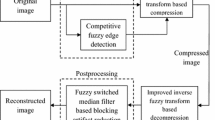Abstract
In this paper, we propose an efficient deinterlacing method for HDTV that preserves image structures, edges, and details. In the human visual system, the eyes are more sensitive to high-frequency information such as edge details than low-frequency information such as image background. Therefore, averaging low-pass filter results is not effective for image enhancement. The proposed method is a weighted filtering approach that generates a half-pixel 9-by-9 edge-based line average window. We also propose pixel-resemblance- and pixel-expansion-based fuzzy weights, which are assigned using a triangular membership function. Compared to conventional format conversion methods, the proposed method outperforms all benchmarks in terms of both objective and subjective qualities.








Similar content being viewed by others
References
Aubertin P, Pierre Langlois JM, Savaria Y (2012) Real-time computation of local neighborhood functions in application-specific instruction-set processors. IEEE Transactions on Very Large Scale Integration (VLSI) Systems 20(11):2031–2043
Brox P, Baturone I, Sanchez-Solano S, (2008) A motion and edge adaptive interlaced-to-progressive conversion using fuzzy logic-based systems, in Proc. IPMU2008, 1175–1182
Brox P, Baturone I, Sánchez-Solano S, Gutiérrez-Ríos J (2014) "edge-adaptive spatial video de-interlacing algorithms based on fuzzy logic," IEEE Trans. Consum Electron 60(3):375–383
Brox P, Baturone I, Sanchez-Solano S, Gutierrez-Rios J (2014) Edge-adaptive spatial video de-interlacing algorithms based on fuzzy logic. IEEE Trans Consumer Electronics 60(3):375–383
Chen T, Wu HR, Yu ZH (2000) Efficient deinterlacing algorithm using edge-based line average interpolation. Opt Eng 39(8):2101–2105
Chen X, Jeon G, Jeong J (2012) A filter switching interpolation method for deinterlacing. SPIE Optical Engineering 51(10):107402
Doyle T (1998) Interlaced to sequential conversion for EDTV application. in Proc. 2nd Int. Working Processing of HDTV, 412–430
Jakhetiya V, Lin W, Jaiswal SP, Guntuku SC, Au OC (2017) Maximum a posterior and perceptually motivated reconstruction algorithm: a generic framework. IEEE Trans Multimedia 19(1):93–106
Jeon G, Jeong J (2006) Designing Takagi-Sugeno fuzzy model based motion adaptive deinterlacing system. IEEE Trans. Consumer Electronics 52(3):1013–1020
Jeon G, You J, Jeong J (2009) Weighted fuzzy reasoning scheme for interlaced to progressive conversion. IEEE Trans Circuits and Systems for Video Technology 19(6):842–855
Jeon G, Park SJ, Fang Y, Anisetti M, Bellandi V, Damiani E, Jeong J (2009) Specification of efficient block matching scheme for motion estimation in video compression. SPIE Optical Engineering 48(12):127005
Jeon G, Anisetti M, Kim D, Bellandi V, Damiani E, Jeong J (2009) Fuzzy rough sets hybrid scheme for motion and scene complexity adaptive deinterlacing. Image Vis Comput 27(4):425–436
Jeon G, Anisetti M, Bellandi V, Damiani E, Jeong J (2009) Designing of a type-2 fuzzy logic filter for improving edge-preserving restoration of interlaced-to-progressive conversion. Inf Sci 179(13):2194–2207
Jeon G, Anisetti M, Lee J, Bellandi V, Damiani E, Jeong J (2009) Concept of linguistic variable-based fuzzy ensemble approach: application to interlaced HDTV sequences. IEEE Trans Fuzzy Systems 17(6):1245–1258
Kovacevic J, Safranek RJ, Yeh EM (1997) Deinterlacing by successive approximations. IEEE Trans Image Process 6(2):339–344
Kuo CJ, Liao C, Lin CC (1996) Adaptive interpolation technique for scanning rate conversion. IEEE Trans Circuits and Syst Video Technol 6(3):317–321
Lee K, Lee C (2013) High quality spatially registered vertical temporal filtering for deinterlacing. IEEE Trans. Consumer Electronics 59(1):182–190
Mahvash H, Savaria Y, Langlois JMP (2011) Enhanced motion compensated deinterlacing algorithm. IET Image Process 6(8):1041–1048
Park MK, Kang MG, Nam K, Oh SG (2003) New edge dependent deinterlacing algorithm based on horizontal edge pattern. IEEE Trans Cons Elect 49(4):1508–1512
Park S.-J, Jeon G, Jeong J (2010) Covariance-based adaptive deinterlacing method using edge map, in Proc. Image Processing Theory Tools and Applications (IPTA), 166–171
Park S-J, Jeon G, Wu J, Jeong J (2013) An interpolation scheme based on Bayes classifier. IS&T/SPIE Journal of Electronic Imaging 22(2):023003
Riquelme J, Morillas S, Peris-Fajarnes G, Castro D (2007) Fuzzy metrics application in video spatial deinterlacing. Lect Notes Comput Sci 4578:349–354
Wang J, Jeon G, Jeong J (2015) A hybrid algorithm using maximum a posteriori for interlaced to progressive scanning format conversion. IEEE/OSA Journal of Display Technology 11(2):183–192
Wu J, Huang J, Jeon G, Cho J, Jeong J, Jiao L (2011) An adaptive autoregressive deinterlacing method. SPIE Optical Engineering 50(5):057001
Wu J, Song Z, Jeon G (2014) GPU-parallel implementation of the edge-directed adaptive intra-field deinterlacing method. IEEE/OSA Journal of Display Technology 10(9):746–753
Wu J, Deng L, Jeo G, et al (2016) GPU-parallel interpolation using the edge-direction based normal vector method for terrain triangular mesh. J Real-Time Image Proc:1–10. doi:10.1007/s11554-016-0575-1
Ying L, Wan X, Jay KC (2002) Introduction to content-based image retrieval-overview of key techniques. In: Castelli V, Bergman D (eds) Image DBs. John Wiley & Sons, Chichester, pp 261–284
Zhang H, Rong M (2014) Deinterlacing algorithm using gradient-guided interpolation and weighted average of directional estimation. IET Image Process 9(6):450–460
Acknowledgements
This work was supported by the Institutes of Convergence Science and Technology, Incheon National University Research Grant in 2015.
Author information
Authors and Affiliations
Corresponding author
Rights and permissions
About this article
Cite this article
Chyung, Y.J., Lee, J.Y., Jung, S.Y. et al. Weighted aggregation and fuzzy-concept-guided signal resemblance and expansion for video format conversion. Multimed Tools Appl 76, 24847–24858 (2017). https://doi.org/10.1007/s11042-017-4641-x
Received:
Revised:
Accepted:
Published:
Issue Date:
DOI: https://doi.org/10.1007/s11042-017-4641-x




